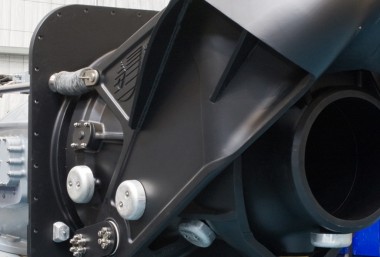Back in the early 1950s, Sir William Hamilton began tinkering with marine waterjets. HamiltonJet, the company he founded, now designs, builds and markets marine waterjet propulsion and vessel-control systems for ships up to 70 metres long. Its products are used in security, rescue and offshore supply vessels, passenger ferries, yachts, and offshore wind farm support boats.
From humble beginnings on the rivers of the Mackenzie Country, HamiltonJet has grown into an innovative global business with product development and manufacturing in Christchurch and sales offices and distributors in over 60 countries.
Naturally, its investment in R&D and product development is significant and its strong focus on innovation means having a robust intellectual property strategy is vital. HamiltonJet has had a longstanding relationship with intellectual property specialists AJ Park.
AJ Park partner Greg West-Walker says a patent dispute experience in the 1990s made HamiltonJet realise it needed to take a more sophisticated approach to its IP strategy.
'We worked with them for months looking at their development processes to create the best IP strategy,' he says.
'Having a well thought-through IP strategy that fits your business is important. In a competitive industry, it's not about developing ideas in isolation. Other companies are likely to be doing similar things and heading in the same direction.'
The focus became on ensuring HamiltonJet could take the technology it had developed to market without clashing with its competitors - something West-Walker says New Zealand companies often get wrong. The challenges HamiltonJet faces are common to Kiwi technology exporters trying to keep up with their multinational competitors.
'HamiltonJet's market is international and its competitors include major Northern Hemisphere companies, which are very IP-savvy and will use the IP system to gain an advantage,' he says.
'You can't play in that market unless you're equally IP-savvy - it's like a chess game.'
In 2000, HamiltonJet had no current patents as its earlier patents had expired. Technical services manager Philip Rae oversees the company's R&D and product development and says that in the 1990s the focus was on expanding the waterjet range for larger vessels.
'Around 10 years ago the focus shifted to new technologies and features, particularly in electronic control systems, and we recognised the need to secure our ability to commercialise our own developments. We elected to do this through patenting ideas that had strategic value to us. We don't waste money on IP that we don't consider to be important to the future of our business.'
AJ Park helped us with wider strategies for protecting and managing IP and took much of the burden of developing initial patent specifications and managing our IP 'briefcase' away from the engineers and technical managers, who were focusing on product development.
- Philip Rae, HamiltonJet
The company now has about 20 current patents or applications pending. But success in this industry isn't just about protecting your innovations - it's also about avoiding the issues that come from infringing the technology being developed by others.
AJ Park partner Michael Brown has a regular 'patent watch' in place for HamiltonJet, checking both here and overseas on the applications other companies are filing.
'It's an early warning system to try and minimise the likelihood of getting blindsided,' says Brown.
'We do a lot of pre-emptive work for HamiltonJet so they have a good idea of what others are developing.'
AJ Park has also been involved in the licensing and opposition processes on behalf of HamiltonJet, representing the company in a number of legal objections to competitor patents - all with positive outcomes.
Trade mark specialist and partner Corinne Cole advises HamiltonJet on its trade mark issues. She says the company has chosen to keep this aspect of its IP simple by focusing on its main brand and protecting the stylised 'J' of its company logo with the words 'HAMILTON JET' in its key markets.
'HamiltonJet has invested a lot in protecting various aspects of its innovations by patents but has kept its trade mark strategy clean and simple. It does not have a multiple brand strategy,' she says.
'By using numbers to identify its accessories, it can avoid infringingon other companies' trade marks and its customers don't have to understand multiple brands.'
CFO Simon Boyd, who's currently working with Blumsky, says AJ Park really understands HamiltonJet's business.
'We're still a fairly small company so we need costeffective solutions. AJ Park recognise that and have been good at helping us invest wisely in our IP protection.'
Philip Rae is also pleased with the work AJ Park has done for HamiltonJet.
'They've navigated us through the entire IP process and provided sound advice around licensing, opposition and infringement issues,' he says. 'AJ Park are extremely professional, personable and very easy to work with. We're impressed with their ability to understand the engineering fundamentals.'
Written by Deirdre Coleman, this case study was featured in #43 of Idealog. Photo courtesy of CWF Hamilton.

